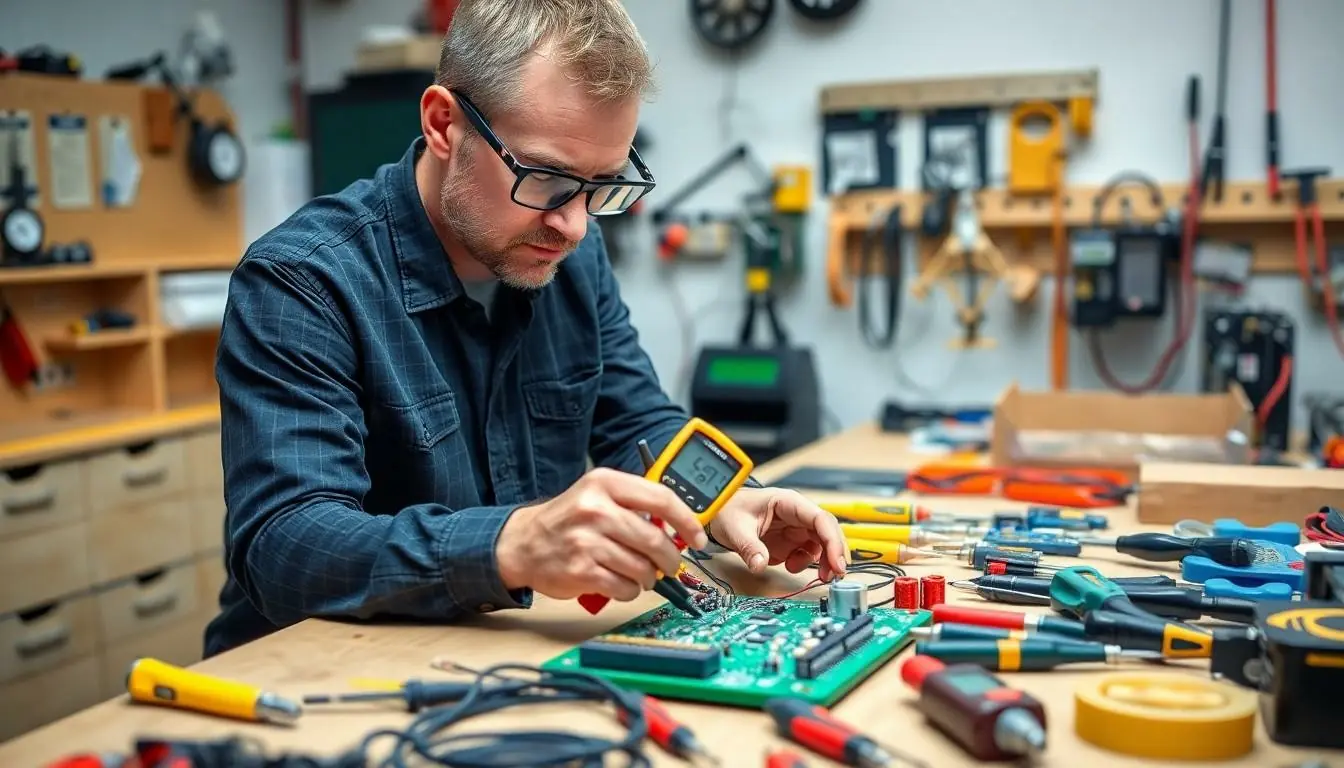Tired of staring at that flickering light bulb or tripping over extension cords? It’s time to roll up those sleeves and dive into the electrifying world of DIY electrical projects. Not only can these projects save money, but they also add a spark of creativity to your home. Imagine transforming a dull space into a well-lit wonderland, all while impressing your friends with your newfound skills.
Table of Contents
ToggleOverview of DIY Electrical Projects
DIY electrical projects offer a practical solution to various household challenges, such as flickering lights and tangled cords. These projects not only save money but also allow homeowners to cultivate their creativity.
Benefits of DIY Electrical Projects
Cost savings represent a crucial advantage. Homeowners avoid labor costs by performing tasks themselves. Energy efficiency improves with upgrades like LED lighting or smart home devices. Personalization becomes easier, as individuals can tailor installations to their specific tastes. Satisfaction arises from completing projects independently, showcasing skills to friends and family. Project varieties range from installing a ceiling fan to rewiring a room, catering to different skill levels and interests.
Safety Considerations
Safety emerges as the foremost priority when engaging in DIY electrical projects. Proper knowledge of electrical systems is essential before undertaking any tasks. Using the correct tools mitigates risks significantly. Furthermore, adhering to local codes and regulations ensures compliance with safety standards. Disconnecting power is crucial before starting any project, reducing the risk of electric shock. Additionally, when in doubt, consulting a licensed electrician provides reassurance and guidance, maintaining a safe environment for all.
Essential Tools for DIY Electrical Projects

Equipping oneself with the right tools is crucial for successful DIY electrical projects. Tools enhance efficiency and ensure safety, making the process smoother.
Basic Tools Required
Commonly required tools include wire strippers, which remove insulation from wires efficiently. A multimeter allows for accurate voltage and current readings, ensuring proper measurements during installations. Screwdrivers of various sizes are essential to tighten connections securely. Pliers help grip and manipulate wires effectively, while electrical tape provides insulation to prevent shorts. Lastly, safety glasses protect the eyes from debris when working with electrical components.
Advanced Tools for Complex Projects
For those engaging in more intricate tasks, specialized tools become necessary. Circuit testers help identify live wires, ensuring safety during any modifications. A conduit bender facilitates the shaping of electrical conduits accurately for neat installations. Voltage testers provide an added layer of safety by verifying that no power flows through wires before work begins. Oscilloscopes draw attention to the signals in complex circuits, aiding in diagnostics. Finally, a drill with a variety of bits enables installation of fixtures securely in walls, enhancing project quality.
Popular DIY Electrical Projects
Engaging in DIY electrical projects offers numerous opportunities for homeowners to enhance their living spaces. Below are some popular projects that cater to a variety of interests and skill levels.
Home Lighting Enhancements
Home lighting enhancements include installing dimmer switches and under-cabinet lighting. Installing dimmer switches allows for adjustable brightness, enhancing ambiance during gatherings. Under-cabinet lighting improves functionality in kitchens, adding both style and visibility. Upgrading light fixtures also presents a chance to refresh décor. Consider replacing outdated fixtures with modern, energy-efficient models to create a fresh look. Adding outdoor lighting improves safety and makes outdoor areas more inviting.
Smart Home Integrations
Smart home integrations enable homeowners to automate and control their lighting and appliances. Installing smart switches and plugs offers the ability to control devices remotely through smartphones or voice commands. Programmable systems can adjust lighting based on time or occupancy, improving energy management. Many people connect smart light bulbs to home assistants for hands-free convenience. Additionally, integrating motion sensors enhances security and convenience by activating lights when someone enters a room.
Energy Efficiency Upgrades
Energy efficiency upgrades provide significant savings and environmental benefits. Swapping out traditional bulbs for LED fixtures reduces energy consumption tremendously. Homeowners can also install programmable thermostats to optimize heating and cooling schedules, further lowering energy bills. Sealing and insulating electrical outlets minimizes drafts, resulting in better energy retention. Adding power strips with smart features helps manage standby energy usage effectively. Upgrading to energy-efficient appliances additionally contributes to reducing overall electricity consumption while delivering improved performance.
Step-by-Step Guides for Selected Projects
This section provides concise, actionable guides for tackling specific DIY electrical projects.
Wiring a New Light Fixture
Start by turning off the power at the circuit breaker. Verify that there’s no electricity using a voltage tester. Remove the existing fixture. Attach the new fixture’s wiring—connect the black wires for power, connect the white wires for neutral, and secure the ground wire to the box. Ensure all connections are tight. Mount the fixture according to the manufacturer’s instructions, then restore power. Test the installation by turning on the switch. Proper wiring enhances light quality and ensures safety.
Installing a Dimmer Switch
Begin this project by disconnecting power at the circuit breaker for safety. Remove the existing switch from the wall. The dimmer switch will typically feature three wires: black, red, and green or bare. Connect the corresponding wires from the dimmer to the power supply and the light fixture. Secure all wire connections and gently push them into the electrical box. Attach the dimmer to the wall and install the faceplate. Once finished, restore power and test the dimmer for proper function. Dimmer switches enhance ambiance and energy efficiency.
Common Mistakes to Avoid
DIY electrical projects require caution and awareness. Several common mistakes could lead to significant issues during or after a project.
Ignoring Safety Protocols
Ignoring safety protocols can result in serious accidents. One critical step involves disconnecting the power supply to avoid electric shocks. Ensuring correct usage of personal protective equipment, like safety goggles and gloves, enhances protection. Verifying the functionality of tools before use also eliminates risks. Following local codes and regulations keeps projects compliant and safe. Consulting resources, such as electrical manuals or videos, reinforces familiarity with safety guidelines. Taking these precautions ensures that electrical projects are executed safely.
Underestimating Project Complexity
Underestimating project complexity often leads to frustration. Each project has unique requirements and challenges that demand attention. Understanding these complexities before starting helps in planning appropriately. Researching the specific tasks involved, including gathering necessary tools, saves time and reduces errors. Electrical systems can exhibit unforeseen issues, making it crucial to remain flexible. Considering consultation with professionals for intricate projects can prevent complications. Preparing for potential obstacles ensures a smoother DIY experience and better results.
Engaging in DIY electrical projects can be a rewarding experience that transforms living spaces while enhancing personal skills. By embracing these projects homeowners can enjoy cost savings and improved energy efficiency. The satisfaction of completing a project independently adds a sense of accomplishment that’s hard to replicate.
Prioritizing safety and using the right tools is crucial for success. With a wide range of projects available there’s something for everyone regardless of skill level. Whether it’s upgrading lighting or integrating smart home technology each project offers a unique opportunity to personalize a home.
Homeowners are encouraged to dive into these projects with confidence. With the right preparation and adherence to safety guidelines they can illuminate their spaces beautifully while enjoying the creative process.




